英语语法精讲:强调句型it练习题
- 格式:doc
- 大小:54.00 KB
- 文档页数:6
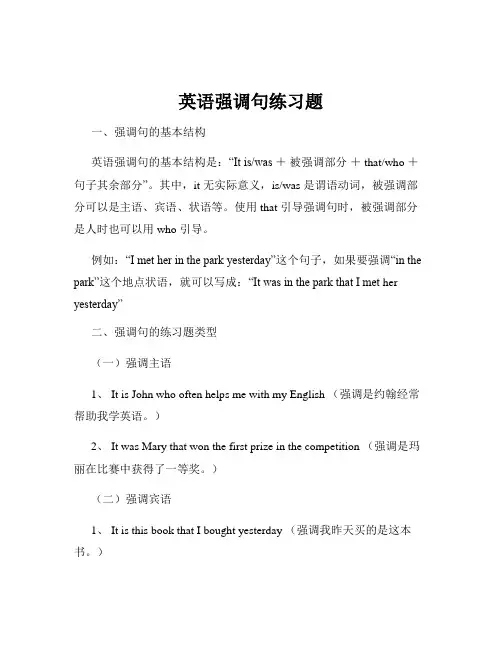
英语强调句练习题一、强调句的基本结构英语强调句的基本结构是:“It is/was +被强调部分+ that/who +句子其余部分”。
其中,it 无实际意义,is/was 是谓语动词,被强调部分可以是主语、宾语、状语等。
使用 that 引导强调句时,被强调部分是人时也可以用 who 引导。
例如:“I met her in the park yesterday”这个句子,如果要强调“in the park”这个地点状语,就可以写成:“It was in the park that I met her yesterday”二、强调句的练习题类型(一)强调主语1、 It is John who often helps me with my English (强调是约翰经常帮助我学英语。
)2、 It was Mary that won the first prize in the competition (强调是玛丽在比赛中获得了一等奖。
)(二)强调宾语1、 It is this book that I bought yesterday (强调我昨天买的是这本书。
)2、 It was the pen that he gave me as a gift (强调他送给我的礼物是这支笔。
)(三)强调状语1、 It was at 8 o'clock that we began our class (强调我们是在 8 点开始上课的。
)2、 It is because of the bad weather that we can't go for a picnic (强调是因为糟糕的天气我们不能去野餐。
)三、强调句的疑问句形式(一)一般疑问句Is it +被强调部分+ that/who +句子其余部分?Was it +被强调部分+ that/who +句子其余部分?例如:Was it Tom who broke the window? (是汤姆打破了窗户吗?)(二)特殊疑问句特殊疑问词+ is/was + it + that +句子其余部分?例如:Where was it that you lost your key? (你是在哪里丢了钥匙?)四、强调句与其他句型的区别(一)强调句与定语从句强调句中的 it 无实际意义,去掉 it is/wasthat 结构后,句子仍然完整。
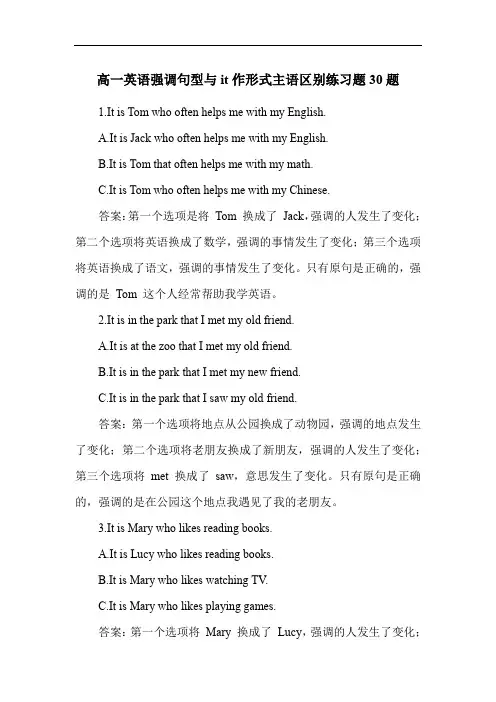
高一英语强调句型与it作形式主语区别练习题30题1.It is Tom who often helps me with my English.A.It is Jack who often helps me with my English.B.It is Tom that often helps me with my math.C.It is Tom who often helps me with my Chinese.答案:第一个选项是将Tom 换成了Jack,强调的人发生了变化;第二个选项将英语换成了数学,强调的事情发生了变化;第三个选项将英语换成了语文,强调的事情发生了变化。
只有原句是正确的,强调的是Tom 这个人经常帮助我学英语。
2.It is in the park that I met my old friend.A.It is at the zoo that I met my old friend.B.It is in the park that I met my new friend.C.It is in the park that I saw my old friend.答案:第一个选项将地点从公园换成了动物园,强调的地点发生了变化;第二个选项将老朋友换成了新朋友,强调的人发生了变化;第三个选项将met 换成了saw,意思发生了变化。
只有原句是正确的,强调的是在公园这个地点我遇见了我的老朋友。
3.It is Mary who likes reading books.A.It is Lucy who likes reading books.B.It is Mary who likes watching TV.C.It is Mary who likes playing games.答案:第一个选项将Mary 换成了Lucy,强调的人发生了变化;第二个选项将读书换成了看电视,强调的事情发生了变化;第三个选项将读书换成了玩游戏,强调的事情发生了变化。
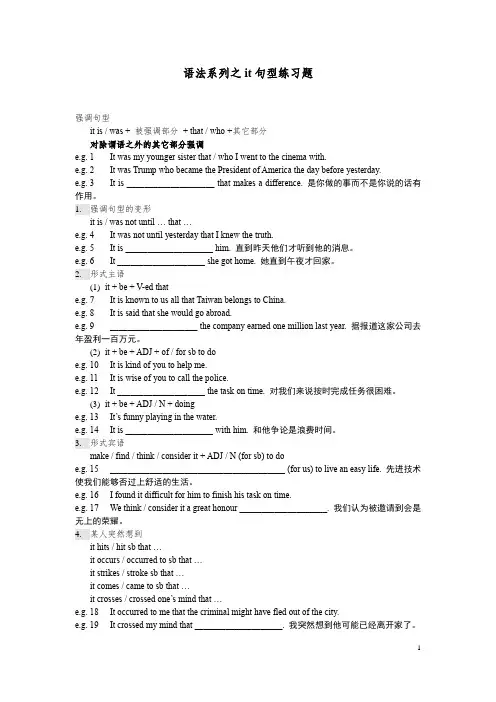
语法系列之it句型练习题强调句型it is / was + 被强调部分+ that / who +其它部分对除谓语之外的其它部分强调e.g. 1It was my younger sister that / who I went to the cinema with.e.g. 2It was Trump who became the President of America the day before yesterday.e.g. 3It is ____________________ that makes a difference. 是你做的事而不是你说的话有作用。
1.强调句型的变形it is / was not until … that …e.g. 4It was not until yesterday that I knew the truth.e.g. 5It is ____________________ him. 直到昨天他们才听到他的消息。
e.g. 6It ____________________ she got home. 她直到午夜才回家。
2.形式主语(1)it + be + V-ed thate.g. 7It is known to us all that Taiwan belongs to China.e.g. 8It is said that she would go abroad.e.g. 9____________________ the company earned one million last year. 据报道这家公司去年盈利一百万元。
(2)it + be + ADJ + of / for sb to doe.g. 10It is kind of you to help me.e.g. 11It is wise of you to call the police.e.g. 12It ____________________ the task on time. 对我们来说按时完成任务很困难。
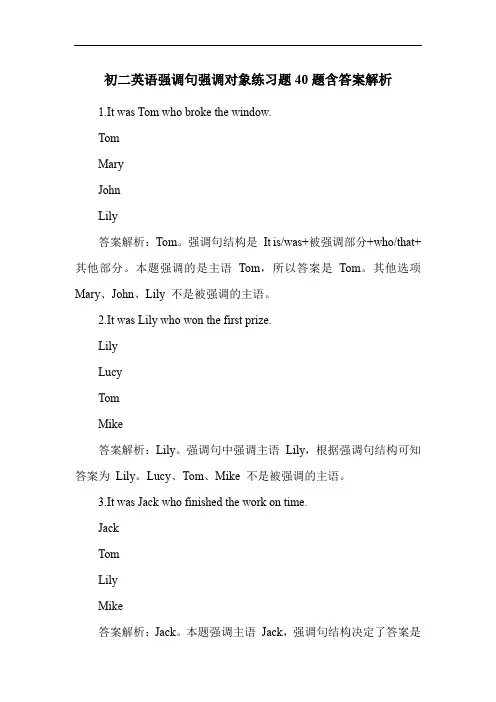
初二英语强调句强调对象练习题40题含答案解析1.It was Tom who broke the window.TomMaryJohnLily答案解析:Tom。
强调句结构是It is/was+被强调部分+who/that+其他部分。
本题强调的是主语Tom,所以答案是Tom。
其他选项Mary、John、Lily 不是被强调的主语。
2.It was Lily who won the first prize.LilyLucyTomMike答案解析:Lily。
强调句中强调主语Lily,根据强调句结构可知答案为Lily。
Lucy、Tom、Mike 不是被强调的主语。
3.It was Jack who finished the work on time.JackTomLilyMike答案解析:Jack。
本题强调主语Jack,强调句结构决定了答案是Jack。
Tom、Lily、Mike 不是被强调的主语。
4.It was Mr. Wang who taught us English.Mr. WangMrs. LiMiss ZhangMr. Liu答案解析:Mr. Wang。
强调主语Mr. Wang,符合强调句结构。
Mrs. Li、Miss Zhang、Mr. Liu 不是被强调的主语。
5.It was Alice who bought the book.AliceLilyTomMike答案解析:Alice。
强调句强调主语Alice。
Lily、Tom、Mike 不是被强调的主语。
6.It was my father who repaired the bike.my fathermy mothermy brothermy sister答案解析:my father。
强调主语my father,强调句结构确定答案。
my mother、my brother、my sister 不是被强调的主语。
7.It was she who sang beautifully.shehetheywe答案解析:she。
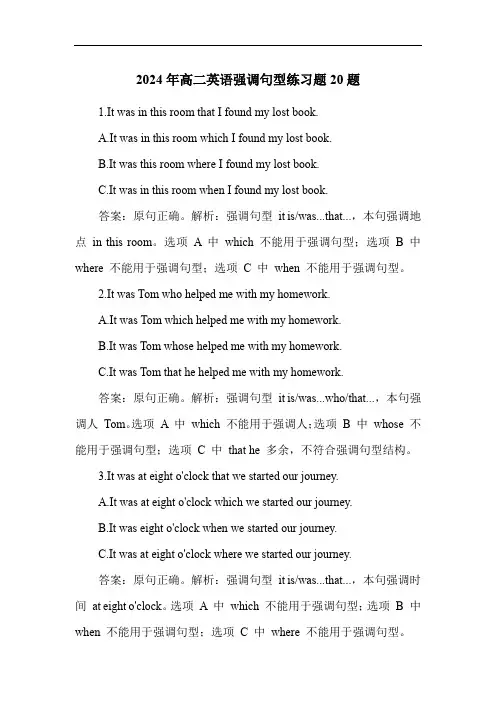
2024年高二英语强调句型练习题20题1.It was in this room that I found my lost book.A.It was in this room which I found my lost book.B.It was this room where I found my lost book.C.It was in this room when I found my lost book.答案:原句正确。
解析:强调句型it is/was...that...,本句强调地点in this room。
选项 A 中which 不能用于强调句型;选项 B 中where 不能用于强调句型;选项C 中when 不能用于强调句型。
2.It was Tom who helped me with my homework.A.It was Tom which helped me with my homework.B.It was Tom whose helped me with my homework.C.It was Tom that he helped me with my homework.答案:原句正确。
解析:强调句型it is/was...who/that...,本句强调人Tom。
选项 A 中which 不能用于强调人;选项B 中whose 不能用于强调句型;选项C 中that he 多余,不符合强调句型结构。
3.It was at eight o'clock that we started our journey.A.It was at eight o'clock which we started our journey.B.It was eight o'clock when we started our journey.C.It was at eight o'clock where we started our journey.答案:原句正确。
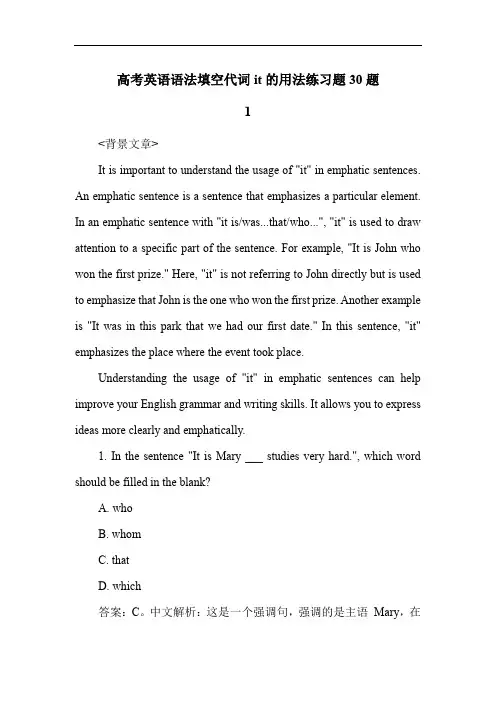
高考英语语法填空代词it的用法练习题30题1<背景文章>It is important to understand the usage of "it" in emphatic sentences. An emphatic sentence is a sentence that emphasizes a particular element. In an emphatic sentence with "it is/was...that/who...", "it" is used to draw attention to a specific part of the sentence. For example, "It is John who won the first prize." Here, "it" is not referring to John directly but is used to emphasize that John is the one who won the first prize. Another example is "It was in this park that we had our first date." In this sentence, "it" emphasizes the place where the event took place.Understanding the usage of "it" in emphatic sentences can help improve your English grammar and writing skills. It allows you to express ideas more clearly and emphatically.1. In the sentence "It is Mary ___ studies very hard.", which word should be filled in the blank?A. whoB. whomC. thatD. which答案:C。
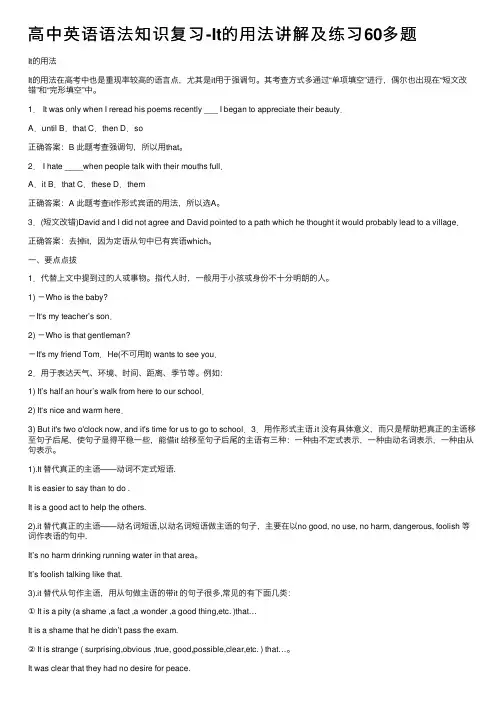
⾼中英语语法知识复习-It的⽤法讲解及练习60多题It的⽤法It的⽤法在⾼考中也是重现率较⾼的语⾔点,尤其是it⽤于强调句。
其考查⽅式多通过“单项填空”进⾏,偶尔也出现在“短⽂改错”和“完形填空”中。
1. It was only when I reread his poems recently ___ I began to appreciate their beauty.A.until B.that C.then D.so正确答案:B 此题考查强调句,所以⽤that。
2. I hate ____when people talk with their mouths full.A.it B.that C.these D.them正确答案:A 此题考查it作形式宾语的⽤法,所以选A。
3.(短⽂改错)David and I did not agree and David pointed to a path which he thought it would probably lead to a village.正确答案:去掉it,因为定语从句中已有宾语which。
⼀、要点点拔1.代替上⽂中提到过的⼈或事物。
指代⼈时,⼀般⽤于⼩孩或⾝份不⼗分明朗的⼈。
1) -Who is the baby?-It‘s my teacher’s son.2) -Who is that gentleman?-It's my friend Tom.He(不可⽤It) wants to see you.2.⽤于表达天⽓、环境、时间、距离、季节等。
例如:1) It’s half an hour’s walk from here to our school.2) It‘s nice and warm here.3) But it's two o'clock now, and it's time for us to go to school.3.⽤作形式主语.it 没有具体意义,⽽只是帮助把真正的主语移⾄句⼦后尾,使句⼦显得平稳⼀些,能借it 给移⾄句⼦后尾的主语有三种:⼀种由不定式表⽰,⼀种由动名词表⽰,⼀种由从句表⽰。
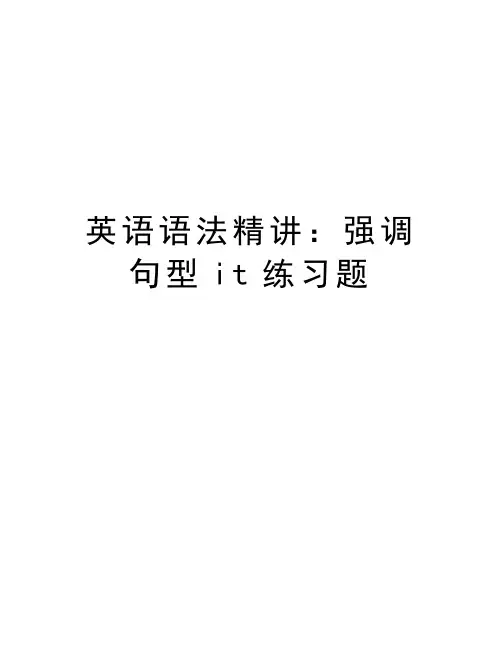
英语语法精讲:强调句型i t练习题强调句型“六强调”It作引导词,用于强调结构,一般用来强调陈述句中除谓语动词以外的大多数句子成分,包括主语、宾语、状语和相关从句等,用来加强语气。
这种强调句型一般用“It be +被强调部分+that(who)+其它部分”来构成,常用于现在时和过去时。
如:I happened to meet Tom in the street the day before yesterday.It was Tom that I happened to meet in the street the day before yesterday. It was I who / that happened to meet Tom in the street the day before yesterday.It was in the street that I happened to meet Tom the day before yesterday. It was the day before yesterday that I happened to meet Tom in the street.I. 如果强调的部分是人,则人称代词须保持原来的形式,这时连接词可用who, whom代替that。
如:It is he who / that teaches us French.It is us who / whom / that he teaches French.II. 如果强调句子中的地点、时间或原因状语时,连接词仍用that,不能用where, when 或why。
如:It is at the street crossing that I met one of my classmates that I had not seen for ages.It was last month that I took part in the Palace ball.我是在上个月参加的宫廷舞会(不能用when)。
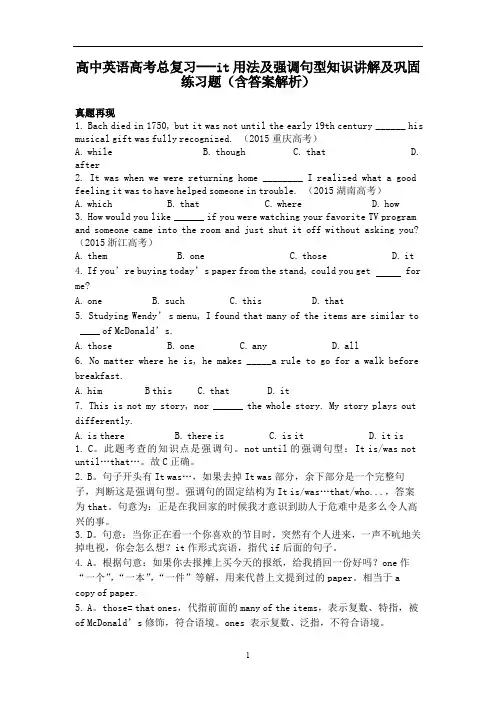
高中英语高考总复习---it用法及强调句型知识讲解及巩固练习题(含答案解析)真题再现1.Bach died in1750,but it was not until the early19th century______his musical gift was fully recognized.(2015重庆高考)A.whileB.thoughC.thatD. after2.It was when we were returning home________I realized what a good feeling it was to have helped someone in trouble.(2015湖南高考)A.whichB.thatC.whereD.how3.How would you like______if you were watching your favorite TV program and someone came into the room and just shut it off without asking you?(2015浙江高考)A.themB.oneC.thoseD.it4.If you’re buying today’s paper from the stand,could you get for me?A.oneB.suchC.thisD.that5.Studying Wendy’s menu,I found that many of the items are similar to ____of McDonald’s.A.thoseB.oneC.anyD.all6.No matter where he is,he makes_____a rule to go for a walk before breakfast.A.him B this C.that D.it7.This is not my story,nor______the whole story.My story plays out differently.A.is thereB.there isC.is itD.it is1.C。
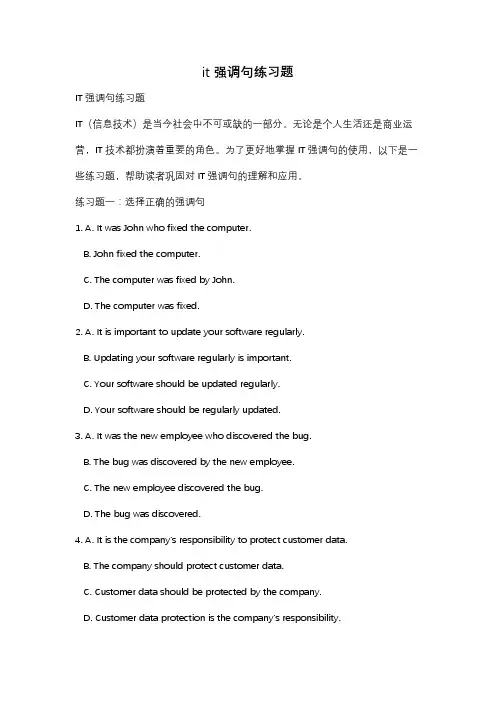
it强调句练习题IT强调句练习题IT(信息技术)是当今社会中不可或缺的一部分。
无论是个人生活还是商业运营,IT技术都扮演着重要的角色。
为了更好地掌握IT强调句的使用,以下是一些练习题,帮助读者巩固对IT强调句的理解和应用。
练习题一:选择正确的强调句1. A. It was John who fixed the computer.B. John fixed the computer.C. The computer was fixed by John.D. The computer was fixed.2. A. It is important to update your software regularly.B. Updating your software regularly is important.C. Your software should be updated regularly.D. Your software should be regularly updated.3. A. It was the new employee who discovered the bug.B. The bug was discovered by the new employee.C. The new employee discovered the bug.D. The bug was discovered.4. A. It is the company's responsibility to protect customer data.B. The company should protect customer data.C. Customer data should be protected by the company.D. Customer data protection is the company's responsibility.练习题二:改写句子,使用强调句1. The website was developed by our team.→ It was our team that developed the website.2. The software must be installed before using it.→ It is necessary to install the software before using it.3. The project was completed on time by the project manager.→ It was the project manager who completed the project on time.4. The data breach was caused by a weak password.→ It was a weak password that caused the data breach.练习题三:填空,使用适当的强调句1. _______ is essential to regularly backup your files to prevent data loss.2. _______ was the team leader who came up with the innovative solution.3. _______ should be taken seriously to protect personal information online.4. _______ is the responsibility of every employee to follow cybersecurity protocols.答案:练习题一:1. A2. B3. C4. A练习题二:1. It was our team that developed the website.2. It is necessary to install the software before using it.3. It was the project manager who completed the project on time.4. It was a weak password that caused the data breach.练习题三:1. It is essential to regularly backup your files to prevent data loss.2. It was the team leader who came up with the innovative solution.3. Online security should be taken seriously to protect personal information.4. It is the responsibility of every employee to follow cybersecurity protocols.通过以上练习题,读者可以更好地理解和运用IT强调句。
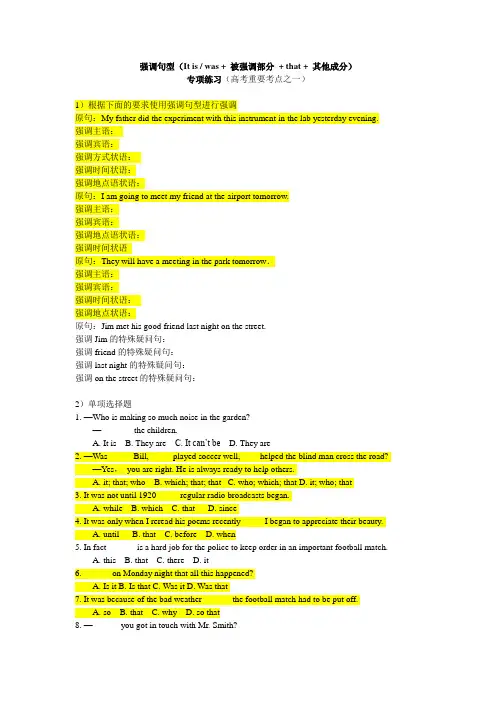
强调句型(It is / was + 被强调部分+ that + 其他成分)专项练习(高考重要考点之一)1)根据下面的要求使用强调句型进行强调原句:My father did the experiment with this instrument in the lab yesterday evening.强调主语:强调宾语:强调方式状语:强调时间状语:强调地点语状语:原句:I am going to meet my friend at the airport tomorrow.强调主语:强调宾语:强调地点语状语:强调时间状语原句:They will have a meeting in the park tomorrow.强调主语:强调宾语:强调时间状语:强调地点状语:原句:Jim met his good friend last night on the street.强调Jim的特殊疑问句:强调friend的特殊疑问句:强调last night的特殊疑问句:强调on the street的特殊疑问句:2)单项选择题1. —Who is making so much noise in the garden?—_______ the children.A. It isB. They areC. It can’t beD. They are2. —Was _____ Bill, _____played soccer well, ____helped the blind man cross the road?—Yes,you are right. He is always ready to help others.A. it; that; whoB. which; that; thatC. who; which; thatD. it; who; that3. It was not until 1920 _____regular radio broadcasts began.A. whileB. whichC. thatD. since4. It was only when I reread his poems recently ___ I began to appreciate their beauty.A. untilB. thatC. beforeD. when5. In fact ______ is a hard job for the police to keep order in an important football match.A. thisB. thatC. thereD. it6. ______ on Monday night that all this happened?A. Is itB. Is thatC. Was itD. Was that7. It was because of the bad weather ______ the football match had to be put off.A. soB. thatC. whyD. so that8. —______ you got in touch with Mr. Smith?—Through a friend of mine.A. How was it thatB. How was itC. It was how thatD. Was it how that9.Was it during the Second World War ____ he died?A. thatB. whileC. in whichD. then10. Was _____that I saw last night at the concert?A. it youB. not youC. youD. that yourself11. Wasn't it Dr. Wang who spoke to you just now?--- ______.A. I didn't know he wasB. Yes, it wasC. No, he wasn'tD. Yes, he did12. Why! I have nothing to confess. _____ you want me to say?A. What is it thatB. What it is thatC. How is it thatD. How it is that13. It is these poisonous products ____ can cause the symptoms of the flu, such as headache and aching muscles.A. whoB. thatC. howD. what14. It was how the young man had learned five foreign languages ______ attracted the audience’s interest.A. so thatB. thatC. whatD. in which15. It was the ability to do the job ____ matters not where you come from or what you are.A. oneB. thatC. whatD. it16. It was about 600 years ago ____ the first clock with a face and an hour hand was made.A. thatB. untilC. beforeD. when17. It was after he got what he had desired ___he realized it was not so important. A. that B. when C. since D. as18.It was only when I reread his poems recently ____ I began to appreciate their beauty.A. untilB. thatC. thenD. so19.It was where there had been a theatre ____ they built a new modern school.A. whereB. in whichC. thatD. so20.It was only with the help of the local people ___ .A. was the mountain climber rescuedB. that the mountain climber was rescuedC. when the mountain climber was rescuedD. then mountain climber was rescued21.It was in the book store ____ I met your brother the other day.A.where B. that C .in which D. in that22. It was not ____ she took off her dark glasses ____ I realized she was a famous film star.A. when; thatB. until; thatC. until; whenD. when; then23.It was ______ back home after the experiment.A. not until midnight did he goB. until midnight that he didn't goC. not until midnight that he wentD. until midnight when he didn't go23.Was it in 1969 ____ the American astronaut succeeded ____landing on the moon?A. when; onB. that; onC. when; inD. that; in24.Was it in this place ____ the last emperor died?A. thatB. in whichC. in whereD. which.25.It was ___ he said ____ disappointed me.A. what; thatB. that; thatC. what; whatD. that; what26.I just wonder ____ that makes him so excited.A. why it doesB. what he does C .how it is D. what it is27.It is what you do rather than what you say ____ matters.A. thatB. whatC. whichD. this28.It was after the invention of printing ___ to publish large numbers of books and pictures.A. were people ableB. that people were ableC. when were people ableD. people were able29.___ was in 1979 ___ I graduated from the university.A. That; thatB. It; thatC. That; whenD. It; when30.It was for this reason ____ her uncle moved out of New York and settled down in a small village.A. whichB. whyC. thatD. how31.It was at the gate ____ he told me the news.A. thatB. whatC. whichD. when32.It was not until 1920 ____ regular radio broadcasts began.A. whileB. whichC. thatD. since33.It wasn't until nearly a month later ___ I received the manager's reply.A. sinceB. whenC. asD. that34. It was ___ back home after the examination.A. not until midnight did he goB. until midnight that he didn't goC .not until midnight that he went D. until midnight when he didn't go35.It was not until ____ that ____ to prepare his lessons.A. did his father come in; the boy beganB. his father came in; the boy beganC. did his father come in; did the boy beginD. his father came in; did the boy begin36.It was with great joy ______ he received the news that his lost daughter had been found.A. becauseB. whichC. sinceD. that37.It was at the very beginning ____ Mr. Fox made the decision ____we should send more fire-fighters there.A.when; which B. when; what C. then; so D. that; that38.--- ___ that he managed to get the information?---Oh, a friend of his helped him.A. Where was itB. What was itC. How was itD. Why was it。
强调句我们在说话或写文章时,为了要突出句子中的某一部分,我们通常会使用某种方法或手段使它突出,以便能引起他人的注意,这就是强调,与此相关的句子就是强调句。
英语表示强调的方法很多,比如在英语口语中可以用重读来强调,在书面语中则可通过使用表示强调意义的词语来强调,也可以通过将被强调成分置于句首这样的“显要”位置来强调,还可以使用专门的强调句式来强调。
一.用It is/was ﹢……﹢that句型1. 陈述句的强调句型:It is/ was + 被强调部分(通常是主语、宾语或状语)+ that/ who(当强调主语且主语指人)+ 其他部分。
在这种强调句式中,一般用that引出句子的其他部分。
如果被强调的部分是表示人的意义的名词时,可以用who代替;如果被强调的部分是表示事物意义的名词时,可以用which代替。
但是,被强调的部分是表示地点、时间意义的名词时,不可以用where 或者when :下面针对I met Li Ming at the railway station yesterday.句子进行强调。
强调主语:It was I that (who)met Li Ming at the railway station yesterday.强调宾语:It was Li Ming that I met at the railway station yesterday.强调地点状语:It was at the railway station that I met Li Ming yesterday.强调时间状语:It was yesterday that I met Li Ming at the railway station.2.一般疑问句的强调句型:同上,只是把is/ was提到it前面。
e.g. Was it yesterday that he met Li Ping?3. 特殊疑问句的强调句型:被强调部分(通常是疑问代词或疑问副词)+ is/ was + it + that/ who + 其他部分?e.g. When and where was it that you were born?二谓语动词的强调若需要强调谓语时,用助动词do/ does或did .当句子中没有其他的助动词时,我们可以在动词前使用助动词do表示对该动词的强调注意:用于表示强调的d o可以有时态的变化但是只用do/ does和did,没有别的形式;用did/ does,后面谓语动词还原原形。
高一英语it的用法及强调句型单选题40题1.It is important for us to learn English well.A.for usB.of usC.to usD.with us答案:A。
本题中it 作形式主语,真正的主语是to learn English well。
“It is + 形容词+ for sb. to do sth.”是固定句型,表示“对某人来说做某事是……的”。
选项B 的“of us”一般用于“It is + 形容词+ of sb. to do sth.”句型,该句型中的形容词表示人的品质、性格等,而important 不是描述人的品质的形容词。
选项C 和D 的“to us”“with us”不符合该句型用法。
2.We think it necessary to do exercise every day.A.necessaryB.importantefulD.good答案:A。
本题中it 作形式宾语,真正的宾语是to do exercise every day。
“think it + 形容词+ to do sth.”是固定用法。
选项B、C、D 虽然也都是形容词,但在这个语境下,根据习惯表达,用necessary 最合适。
3.It is a pity that he missed the concert.A.a pityB.a shameC.a surpriseD.a wonder答案:A。
本题中it 作形式主语,真正的主语是that he missed the concert。
“It is a pity that...”是固定句型,表示“……很遗憾”。
选项B“a shame”也有遗憾的意思,但通常用法不同。
选项C“a surprise”是惊讶的意思,选项D“a wonder”是奇迹的意思,均不符合语境。
4.She made it clear that she didn't want to go.A.clearB.obviousC.evidentD.apparent答案:A。
高一英语强调句型与it作形式主语区别练习题30题含答案解析1.It is important that we study hard.A.thatB.thisC.whatD.it答案解析:A。
本题考查it 作形式主语,真正的主语是后面的that 从句。
B 选项this 不能作形式主语;C 选项what 引导名词性从句时不能作形式主语;D 选项it 在本题中已经是形式主语,不能再重复使用。
2.It was in the park that I met him.A.thatB.whenC.whereD.what答案解析:A。
本题考查强调句型,强调地点状语in the park。
B 选项when 引导时间状语从句;C 选项where 引导地点状语从句;D 选项what 引导名词性从句。
3.It is a pity that he didn't come.A.thatB.thisC.whatD.it答案解析:A。
本题考查it 作形式主语,真正的主语是后面的that 从句。
B 选项this 不能作形式主语;C 选项what 引导名词性从句时不能作形式主语;D 选项it 在本题中已经是形式主语,不能再重复使用。
4.It was yesterday that he came back.A.thatB.whenC.whereD.what答案解析:A。
本题考查强调句型,强调时间状语yesterday。
B 选项when 引导时间状语从句;C 选项where 引导地点状语从句;D 选项what 引导名词性从句。
5.It is said that he is very clever.A.thatB.thisC.whatD.it答案解析:A。
本题考查it 作形式主语,真正的主语是后面的that 从句。
B 选项this 不能作形式主语;C 选项what 引导名词性从句时不能作形式主语;D 选项it 在本题中已经是形式主语,不能再重复使用。
人教版高一英语强调句型与it作形式主语区别练习题30题1.It was in the park that I met my old friend.A.It was in the park where I met my old friend.B.It was the park that I met my old friend in.C.It was at the park that I met my old friend.答案解析:B。
A 选项中where 引导定语从句,不是强调句型,错误。
C 选项中at the park 搭配错误,in the park 才是正确的,错误。
B 选项符合强调句型it is/was...that...的结构,正确。
强调句型中被强调部分如果是地点状语,后面要用in/at 等介词加地点。
2.It was yesterday that he came back.A.It was on yesterday that he came back.B.It was in yesterday that he came back.C.It was yesterday when he came back.答案解析:A 和 B 选项中on yesterday 和in yesterday 都是错误表达,yesterday 前不需要加介词。
C 选项中when 引导定语从句,不是强调句型,错误。
本题正确答案是题干,强调句型it is/was...that...,强调时间状语yesterday。
3.It is he who/that is responsible for this.A.It is him who is responsible for this.B.It is he which is responsible for this.C.It is he whose is responsible for this.答案解析:A 选项中him 是宾格,不能做强调句型中的主语,错误。
高一英语强调句型与it作形式主语区别完形填空题30题答案解析版1It is important to learn English well.___1___ is known to all that English is widely used in the world.___2___ is no doubt that mastering English can bring many benefits.___3___ is necessary for us to study hard.___4___ is English that helps us communicate with people from different countries.___5___ is clear that we should pay more attention to English learning.1.A.It B.What C.As D.That答案:A。
解析:It is known to all that...是固定句型,it 作形式主语,真正的主语是that 引导的从句。
B 选项what 引导主语从句时,句子缺少谓语动词;C 选项as 不能用在此处;D 选项that 引导主语从句时,句子结构不对。
2.A.There B.It C.This D.That答案:A。
解析:There is no doubt that...是固定句型,there be 句型表示“有”,这里是“毫无疑问”的意思。
B 选项it 作形式主语时,后面一般不跟no doubt;C 选项this 和D 选项that 不能用在此处。
3.A.It B.This C.That D.What答案:A。
解析:It is necessary for sb. to do sth.是固定句型,it 作形式主语,真正的主语是后面的不定式短语。
B 选项this 和C 选项that 不能用在此处;D 选项what 引导主语从句时,句子缺少谓语动词。
人教版高一英语强调句型与it作形式主语区别练习题30题【含答案解析】1.It was in the park ____ I met my old friend.A.thatB.whereC.whenD.which答案解析:A。
本题考查强调句型。
强调句型的基本结构是“It is/was + 被强调部分+ that/who + 其他部分”。
这里强调的是地点状语in the park,所以只能用that。
B 选项where 引导定语从句或地点状语从句;C 选项when 引导时间状语从句;D 选项which 引导定语从句,均不符合强调句型结构。
2.It was at seven o'clock ____ he went to school.A.thatB.whenC.whileD.as答案解析:A。
强调句型,强调时间状语at seven o'clock,用that。
B 选项when 引导时间状语从句;C 选项while 强调两个动作同时进行;D 选项as 可引导时间状语从句等,均不符合强调句型结构。
3.It was Tom ____ helped me with my homework.A.thatB.whoD.which答案解析:B。
强调句型,强调主语Tom,且是人,用who。
that 也可以用于强调人或物,但在强调人的时候,who 更常用。
C 选项whom 是宾格形式,在句子中作宾语;D 选项which 引导定语从句,用于指物,均不符合强调句型结构。
4.It was his kindness ____ moved me.A.thatB.whichC.whatD.who答案解析:A。
强调句型,强调主语his kindness,用that。
B 选项which 引导定语从句,用于指物;C 选项what 一般引导名词性从句;D 选项who 强调人,均不符合强调句型结构。
5.It was yesterday ____ I came across her.A.thatB.whenC.whereD.which答案解析:A。
强调句型“六强调”It作引导词,用于强调结构,一般用来强调陈述句中除谓语动词以外的大多数句子成分,包括主语、宾语、状语和相关从句等,用来加强语气。
这种强调句型一般用“It be +被强调部分+that(who)+其它部分”来构成,常用于现在时和过去时。
如:I happened to meet Tom in the street the day before yesterday.It was Tom that I happened to meet in the street the day before yesterday.It was I who / that happened to meet Tom in the street the day before yesterday. It was in the street that I happened to meet Tom the day before yesterday.It was the day before yesterday that I happened to meet Tom in the street. I. 如果强调的部分是人,则人称代词须保持原来的形式,这时连接词可用who, whom代替that。
如:It is he who / that teaches us French.It is us who / whom / that he teaches French.II. 如果强调句子中的地点、时间或原因状语时,连接词仍用that,不能用where, when或why。
如:It is at the street crossing that I met one of my classmates that I had not seen for ages.It was last month that I took part in the Palace ball.我是在上个月参加的宫廷舞会(不能用when)。
It was for this reason, I suppose, that the book took a long time to come out.我想正是由于这种原因使得那本书很长时间才出版(不能用why)。
III. 当强调not…until结构时,须将not until连用,后面接肯定式。
It is/was not until +从句+that+主语。
如:It was not until at that time that I realized what trouble he was in.It was not until the bell rang that the teacher stopped his lesson.IV. 强调句型的一般疑问句须将be的形式提前,放在句首。
如:Was it the book of this kind that they liked in their childhoods?Can it be Jack that stole the purse of the woman?V. 强调句型还可用特殊疑问句。
如:What was it that started the big fire in the building?When was it that she returned the book to the library?Where was it that he had worked before he came to this place?VI. 强调句型与主语从句的区别:强调句型可以还原成正常语序的句子,也就是说,强调句型中去掉It be… that后,句子仍然通顺,意义也依然完整,只是没有那么强调突出。
而含主语从句的复合句中的it是指示代词,后面多为系表结构或被动语态。
如果去掉It be…that,句子就不通顺了。
如:It was in the lab that was taken charge by Professor Harris that they did the experiment.(=They did the experiment in the lab that was taken charge by Professor Harris.) It is certain that he is honest and modest.It is known to all that paper was made first in China.英语中,表示强调的方法一般分为三种:位置的强调;用词强调;句型强调。
如:一、位置强调英语句子的语序,一般为:主、谓、宾、表、状。
有时为了强调某个成份,就故意将它移到句首或句末。
如:A.强调主语及状语。
如:(1)I was reading English this morning. —This morning, I was reading English. 今天早晨,我一直在读英语。
(2)I’ll go to see Li Lei tomorrow. —Tomorrow, I’ll go to see Li Lei. 明天,我要去看李蕾。
B.强调谓语(as, though引导的让步状语从句)(1)Though he will try, he can’t succeed. —Try as / though he will, he can’t succeed. (2)Though she can sing, she can’t sing well. —Sing though / as she can, she can’t sing well.C.强调宾语或表语(as, though引导的让步状语从句)(1)Though he learnt English, he didn’t learn it well. —English as / though he learnt, he didn’t le arn it well.(2)Though he is ill, he keeps on working. —Ill as / though he is, he keeps on working.二、用词强调英语中强调的另一种方法,就是用不同的词进行夸张从而达到强调的目的。
用词强调有以下几种形式。
A.在句子中的谓语动词前加助动词do, 对谓语进行强调。
如:(1)I do like swimming. 我的确喜欢游泳。
(2)He did go there last night. 他昨天晚上的确去过那儿。
B.用awfully, badly, dead, deeply, ever, extremely, highly, indeed, lightly, not…at all, particularly, p retty, really, so, strongly, terribly, utterly, very, very much,等副词修饰以加强语气。
如:(1)He wants to get it very much. 他非常像得到它。
(2)I miss you terribly. 我非常思念你。
C.用短语at all, on earth, in the world, under the sun等表示强调,意思是:到底,究竟,根本。
如:(1)I don’t know it at all. 我一点也不知道。
(2)What on earth are you doing there? 你到底在那干什么?4) 用重复某一个词或短语来强调。
如:(1)He thought and thought, and suddenly he got a good idea. 他想啊想啊,突然想到了一个好主意。
(2)He ran and ran, and at last he caught up with other students. 终于赶上了其他的同学们。
三、用句子来强调A.句型强调英语中最常见的强调手段,也是我们必须要掌握的方法就是句型强调,即:强调句型。
It is / was + 被强调的部分+ that (who)…如:(1)It was in the room that Li Lei was born. 李蕾出生就在这间房子。
(2)It is Wei Fang who has broken the record. 就是魏方打破了纪录。
B.在使用强调句型时须注意的几个问题:(A)原句子是现在时或将来时,强调句用It is + 被强调的部分+ that (who)…; 若原句子是过去时,强调句用:It was + 被强调的部分+ that (who)…(1)Li Lei’s father will work in America. —It is in America that Li Lei’s father will work. 李蕾的父亲的工作将就在美国。
(2)I studied at this school a few years ago. —It was at this school that I studied a few years ago.几年前我就在这所学校读书。
(B)即使被强调的部分是复数,It后面始终用单数形式。
如(from )(1)Tom and Lucy gave us much help. —It was Tom and Lucy that gave us much help. 正是汤姆和露西给了我们很多的帮助。
(2)I saw swans in the lake yesterday. —It was swans that I saw in the lake yesterday. 昨天我看到在湖里的就是天鹅。
(C)强调人时,可用who 代替that, 但若强调时间、地点、原因、方式时,不能用when, where, why, how代替that。
如:(1)It is our teacher who / that helps us make great progress. 正是我们的老师帮助我们取得了很大的进步。
(2)It is by bus that I go to school every day. 每天我就是乘公共汽车上学。
(D)在强调not…until结构中的时间状语时,应将not移到until前,再将not until部分移到被强调的位置。
如:I didn’t go to bed until twelve o’clock last night. —It was not until twelve o’clock last night that I went to bed. 昨天晚上我一直到十二点才睡。